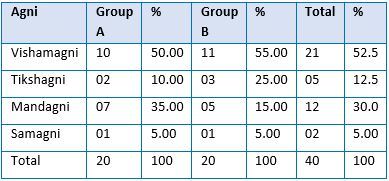Comparative clinical study to evaluate the efficacy of Vartaku Gutika and Chitrakadi Vati in the management of Grahani Roga (Irritable Bowel Syndrome)
DOI:
https://doi.org/10.21760/jaims.7.9.1Keywords:
Grahani, IBS, Chitrakadi vati, Vartaku GutikaAbstract
Background: Grahani is a disease of great clinical relevance in modern era because of it’s directly link with improper food habits and stressful lifestyle. Agnimandhya is root cause of Amadosha and it is crucial factor for Grahani and causes Pakwa Apakwa Mala Pravritti. It can be correlated to irritable bowel syndrome. About 15% of the general populations have symptoms that justify diagnosis of IBS. As in the Grahani Agnimandhya is important factor in Samprapti, so it should be treated with Agnivardhan Yogas. Vartaku Gutika which is described in Chakradatta as reseach drug and Chitrakadi Vati mentioned in Charak Samhita for control group. Objectives: To evaluate the effect of Vartaku Gutika and to compare the effect Vartaku Gutika and Chitrakadi Vati in the management of Grahani. Methods: 40 enrolled subjects completed the course of intervention. Randomly they were divided into two groups, group A was given Chitrakadi Vati and group B Vartaku Gutika abd they were adviced 500 mg of tablet two times after food with Ushna Jala, and were adviced to follow Pathya Aahara. Statistical analysis with paired t test, Wilcoxon signed rank test, Mann Whitney test, Mc Nemar test and Chi square test was performed for numerical, ordinal and nominal data respectively. Results: Statistically significant reduction of Lakshana of Grahani in both the group was observed. Overall Vartaku Gutika has more improvement in compared to Chitrakadi Vati. Conclusion: Both Vartaku Gutika and Chitrakadi Vati breaking the pathology of Grahani, but in this study Vartaku Gutika is more effective than compared to Chitrakadi Vati.
Downloads
References
Agnivesha, Charaka Samhita revised by Charaka and Dridhbala with the Ayurveda Deepika commentary of Chakrapanidatta, Edited by Vaidya Jadavji Trikamji, Chaukhambha Orientalia, Varanasi, Reprint Edition 2015, Pp-738 p-517
Munjal YP, API Textbook of Medicine, Volume 1, 9th edition, Chapter 13th, Pp-2086, p- 821
Schmulson MJ, Drossman DA. What Is New in Rome IV. J Neurogastroenterol Motil. 2017 Apr 30;23(2):151-163. doi: 10.5056/jnm16214. PMID: 28274109; PMCID: PMC5383110.)
Epidemiological and clinical perspectives on irritable bowel syndrome in India, Bangladesh and Malaysia: A review. World journal of gastroenterology vol.23,37(2017)6788-6801.)
Tripathi Indradeva, Chakradatta of Sri Chakrapanidatta, 1997, 3rd edition, editor Ramanath Dwivedi; Vidyaprabha Hindi Commentary, Varanasi, Chaukhambha Sanskrit Samsthan: Pp-542, p-48
Agnivesha, Charaka samhita revised by Charaka and Dridhabala with the yurveda Deepika Commentary of Chakrapanidatta, Edited by Vaidya Jadavji Trikamji, Chaukhambha Orientalia, Varanasi, reprint edition 2015, Pp-738 p-520
Maxwell PR, Mendall MA, Kumar D. Irritable bowel syndrome. Lancet. 1997;350(9092):1691–1695
Buscail C, Sabate JM, Bouchocha M et al. Association between self-reported vegetarian diet and the irritable bowel syndrome in the French NutriNet cohort. PLoS One.2017;12:e0183039
K. Madhava Chetty et al, Pharmaceutical Studies and Therapeutic Uses of Plumbago Zeylanica L. Roots (Chitraka, Chitramulamu), Ethnobotanical Leaflets 10: 294-304. 20
Nishigandha Pradip Jagtap, Nilima Wadnewar. A pharmacological perspective of Ayurvedic Upvisha-Snuhi (Euphorbia Nerifolia Linn.) International Ayurvedic Medical Journal, September,2009
https://www.ayurtimes.com/rock-salt- sendha-namak-halite-benefits-uses/ (accessed on March,2022)
http://www.livemint.com/r/LiveMint/ Period1/oldpdf/52d367ae-f4a8-463f- aec4 5ad563f1257f.pdf
McEvoy, G.K. (Ed.). American Hospital Formulary Service. AHFS Drug Information. American Society of Health-System Pharmacists, Bethesda, MD. 2006., p. 2585















